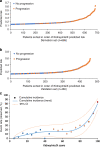Derivation and validation of a machine learning risk score using biomarker and electronic patient data to predict progression of diabetic kidney disease
- PMID: 33797560
- PMCID: PMC8187208
- DOI: 10.1007/s00125-021-05444-0
Derivation and validation of a machine learning risk score using biomarker and electronic patient data to predict progression of diabetic kidney disease
Abstract
Aim: Predicting progression in diabetic kidney disease (DKD) is critical to improving outcomes. We sought to develop/validate a machine-learned, prognostic risk score (KidneyIntelX™) combining electronic health records (EHR) and biomarkers.
Methods: This is an observational cohort study of patients with prevalent DKD/banked plasma from two EHR-linked biobanks. A random forest model was trained, and performance (AUC, positive and negative predictive values [PPV/NPV], and net reclassification index [NRI]) was compared with that of a clinical model and Kidney Disease: Improving Global Outcomes (KDIGO) categories for predicting a composite outcome of eGFR decline of ≥5 ml/min per year, ≥40% sustained decline, or kidney failure within 5 years.
Results: In 1146 patients, the median age was 63 years, 51% were female, the baseline eGFR was 54 ml min-1 [1.73 m]-2, the urine albumin to creatinine ratio (uACR) was 6.9 mg/mmol, follow-up was 4.3 years and 21% had the composite endpoint. On cross-validation in derivation (n = 686), KidneyIntelX had an AUC of 0.77 (95% CI 0.74, 0.79). In validation (n = 460), the AUC was 0.77 (95% CI 0.76, 0.79). By comparison, the AUC for the clinical model was 0.62 (95% CI 0.61, 0.63) in derivation and 0.61 (95% CI 0.60, 0.63) in validation. Using derivation cut-offs, KidneyIntelX stratified 46%, 37% and 17% of the validation cohort into low-, intermediate- and high-risk groups for the composite kidney endpoint, respectively. The PPV for progressive decline in kidney function in the high-risk group was 61% for KidneyIntelX vs 40% for the highest risk strata by KDIGO categorisation (p < 0.001). Only 10% of those scored as low risk by KidneyIntelX experienced progression (i.e., NPV of 90%). The NRIevent for the high-risk group was 41% (p < 0.05).
Conclusions: KidneyIntelX improved prediction of kidney outcomes over KDIGO and clinical models in individuals with early stages of DKD.
Keywords: Biomarkers; Diabetic kidney disease; Electronic data; Machine learning; Prediction.
Figures



References
-
- USRDS (2018) Annual data report: atlas of chronic kidney disease and end-stage renal disease in the United States. National Institutes of Health, National Institute of Diabetes and Digestive and Kidney Diseases
-
- KDIGO Clinical practice guideline for the evaluation and management of chronic kidney disease. Kidney Int Suppl. 2012;3:1–163.
Publication types
MeSH terms
Substances
Grants and funding
- R01 HL085757/HL/NHLBI NIH HHS/United States
- U01 HG009610/HG/NHGRI NIH HHS/United States
- IK2 CX001780/CX/CSRD VA/United States
- R01 DK108803/DK/NIDDK NIH HHS/United States
- U01 OH011326/OH/NIOSH CDC HHS/United States
- R01 DK126477/DK/NIDDK NIH HHS/United States
- U01 DK106962/DK/NIDDK NIH HHS/United States
- R01 DK115562/DK/NIDDK NIH HHS/United States
- U01 HG007278/HG/NHGRI NIH HHS/United States
- R01 DK112258/DK/NIDDK NIH HHS/United States
- K23 DK107908/DK/NIDDK NIH HHS/United States
- U01 DK116100/DK/NIDDK NIH HHS/United States
- K23 DK124645/DK/NIDDK NIH HHS/United States
LinkOut - more resources
Full Text Sources
Other Literature Sources
Medical
Research Materials
Miscellaneous

